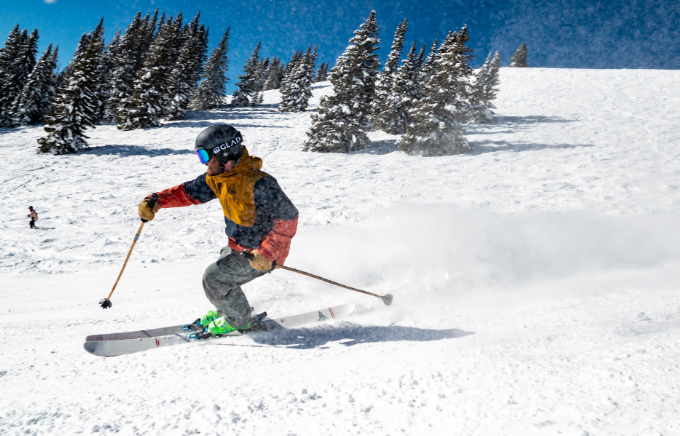
Embracing the thrill of the icy slopes, the crisp mountain air, and the breathtaking vistas, skiing is a sport that invites us to conquer the winter's chill and experience the pure joy of gliding through snow-covered landscapes.
But as the temperatures drop and the snowflakes fall, the art of staying warm while skiing becomes essential for an enjoyable and comfortable experience.
In this comprehensive blog, we delve into the world of winter sport and fashion, uncovering a treasure trove of tips, tricks, and expert advice to keep you cozy and snug during your skiing adventures.
Whether you're a seasoned ski enthusiast or a first-time snow explorer, join us as we explore the latest gear, layering strategies, and insider insights that will not only keep you warm but also elevate your skiing escapades to new heights of comfort and excitement.
1) Invest In Quality Heated Clothes

When it comes to tackling the frosty slopes and embracing the snowy wilderness, the significance of heated clothing cannot be overstated. In the realm of winter sports like skiing, maintaining warmth isn't just a matter of comfort; it's a critical aspect of safety and overall enjoyment.
Heated clothing, with its innovative technology and design, plays a pivotal role in ensuring that your body remains at a comfortable temperature throughout your skiing adventure. Here's why heated clothing is of paramount importance:
- Enhanced Comfort: Traditional winter clothing relies on layering to trap body heat, but heated clothing takes it a step further by actively generating warmth. This means you can bid adieu to the uncomfortable sensation of freezing cold extremities and instead revel in the coziness of even heat distribution.
- Optimized Performance: When your body is shivering from the cold, your muscles tend to tense up, impacting your overall mobility and skiing performance. Heated clothing helps maintain your body's core temperature, keeping your muscles relaxed and allowing you to move freely, thus enhancing your skiing technique and control.
- Safety First: Cold temperatures can lead to more than just discomfort; they can result in frostbite and hypothermia, both of which pose serious health risks. Heated clothing acts as a protective shield against these dangers, minimizing the chances of frost-related ailments and ensuring you can enjoy your skiing experience without jeopardizing your well-being.
- Extended Playtime: Have you ever had to cut your skiing adventure short because the chill became unbearable? Heated clothing extends your time on the slopes by keeping you warm and comfortable. You can relish every moment on the snow-covered landscape without constantly seeking refuge in the warming hut.
- Customizable Heating: Many heated clothing options allow you to adjust the level of warmth according to your preference. This adaptability ensures that you're not overheating during more intense skiing sessions or feeling underdressed during gentler runs.
- Innovative Technology: Modern heated clothing is designed with advanced technology that's both efficient and lightweight. Battery-powered heating elements are seamlessly integrated into various garments, from jackets and gloves to socks and base layers, offering a wide range of options to keep different parts of your body warm.
In a nutshell, heated clothing has revolutionized the way we experience winter sports like skiing. It's no longer just a matter of piling on layers and hoping for the best; it's about embracing cutting-edge solutions that prioritize warmth, safety, and overall enjoyment. So, if you're ready to conquer the slopes without battling the cold, heated clothing is your ultimate ally, ensuring that your skiing adventures are as comfortable and exhilarating as possible.
Check out my guides on the best heated gear:
2) Layering

Layering is a strategic approach to dressing for outdoor activities, including skiing. The layering system consists of three main layers, each serving a specific purpose:
Base Layer:
- The base layer is the layer closest to your skin. Its primary function is to manage moisture by wicking sweat away from your body. This prevents you from feeling damp, which can lead to discomfort and coldness.
- Choose a base layer made of moisture-wicking materials like synthetic blends (polyester, nylon) or natural fibers like merino wool. Merino wool is particularly popular for its natural moisture-wicking properties and odor resistance.
- Base layers come in varying thicknesses for different levels of insulation. Consider the weather conditions and your personal preferences when choosing a weight.
Mid-Layer:
- The mid-layer provides insulation by trapping warm air close to your body. This layer's thickness and material depend on the temperature and your activity level.
- Fleece jackets, down or synthetic insulated jackets, and softshell garments are commonly used mid-layers. They offer warmth without being overly bulky.
Outer Layer:
- The outer layer, often called the shell layer, protects you from wind, snow, and moisture. It should be both waterproof and windproof.
- Ski-specific jackets and pants made from materials like Gore-Tex are popular choices for the outer layer. They allow moisture (sweat) to escape while preventing external elements from getting in.
How Layering Works:
The layering system works by creating a microclimate close to your body. Each layer serves a specific purpose:
- The base layer wicks moisture away from your skin, keeping you dry and preventing the cooling effect of damp clothing.
- The mid-layer traps warm air, providing insulation against the cold.
- The outer layer shields you from wind, snow, and wet conditions.
Layering Tips:
Avoid Cotton: Cotton retains moisture, making you feel cold when it gets wet. Avoid cotton base layers.
Adjust Layers: As you become more active or the weather changes, you can adjust layers to regulate your body temperature. You might unzip your jacket or remove your mid-layer during intense skiing and add them back during breaks.
No Gaps: Ensure there are no gaps in your layers where cold air can seep in. For instance, your gloves should overlap with your jacket sleeves to prevent cold air from reaching your wrists.
Packability: Layering allows you to adapt to changing conditions. If it gets warmer, you can easily remove a layer and stow it in your backpack.
Try Before You Buy: Experiment with different combinations of base, mid, and outer layers to find what works best for your body and the conditions you're skiing in.
Keep it Loose: Don't make your layers too tight. Air trapped between layers helps with insulation.
Quality Matters: Invest in high-quality, technical clothing designed for skiing. While initial costs might be higher, the durability and performance justify the investment.
Remember that staying warm while skiing is not just about piling on as many layers as possible. It's about finding the right combination of layers that effectively manage moisture, provide insulation, and protect you from the elements while allowing you to move comfortably on the slopes.
3) Quality Gloves Or Mittens
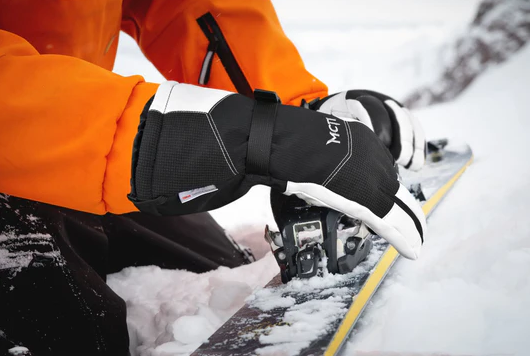
High-quality gloves or mittens are essential for keeping your hands warm and comfortable while skiing. Here's a more detailed look at why they are crucial and what to consider when choosing them:
Importance of Quality Gloves or Mittens:
- Extreme Conditions: Skiing often exposes your hands to harsh weather conditions, including cold temperatures, wind, and snow. Quality gloves or mittens are designed to withstand these conditions and keep your hands warm.
- Dexterity and Control: While warmth is crucial, you also need gloves that allow you to maintain good dexterity and control over your ski poles and equipment. Quality gloves strike a balance between insulation and freedom of movement.
- Comfort and Protection: Well-constructed gloves or mittens are comfortable to wear for extended periods and provide protection against moisture, wind, and abrasions.
Factors to Consider When Choosing Gloves or Mittens:
- Insulation: Look for gloves with sufficient insulation to keep your hands warm. Different gloves offer varying levels of insulation, so consider the temperature range you'll be skiing in.
- Waterproof and Breathability: Waterproof gloves prevent moisture from snow or slush from seeping in, while breathability allows sweat to escape. Look for gloves with waterproof and breathable membranes like Gore-Tex.
- Material: High-quality gloves often use materials like leather, synthetic blends, or a combination of both. Leather gloves provide durability, while synthetic materials offer flexibility and moisture resistance.
- Inner Liner: Some gloves come with removable inner liners that can be beneficial on warmer days or when you need to dry out your gloves.
- Cuff Style: Gloves or mittens with longer cuffs that can be pulled over your jacket sleeves help prevent snow and cold air from entering.
- Warmth vs. Dexterity: Mittens generally provide more warmth because they keep your fingers together, but they offer less dexterity compared to gloves. Choose based on your preferences and the activities you'll be engaging in.
- Wrist Closure: Adjustable wrist closures can help create a snug fit and keep cold air and snow out.
- Touchscreen Compatibility: Some gloves have touchscreen-compatible fingertips, allowing you to use your smartphone without removing your gloves.
- Size and Fit: Gloves that are too tight can restrict blood flow and reduce warmth, while those that are too loose might not provide proper insulation. Make sure to try on different sizes and brands to find the best fit for your hands.
Layering with Gloves or Mittens:
Consider the layering principle when it comes to gloves or mittens too:
- Base Layer Gloves: Thin, moisture-wicking liner gloves can be worn as a base layer to provide an extra layer of insulation and manage moisture.
- Insulating Gloves: For colder conditions, layer over the liner gloves with thicker, insulated gloves or mittens for added warmth.
- Outer Shell Gloves: If conditions are particularly wet or windy, you can opt for a waterproof and windproof shell glove over your insulating gloves.
Remember that your hands are exposed to the elements, so investing in high-quality gloves or mittens is crucial for both comfort and safety while skiing. Always test your gloves before hitting the slopes to ensure they provide the right balance of warmth, dexterity, and protection.
4) Warm Hat Or Helmet Liner

keeping your head warm is vital for maintaining overall body warmth while skiing. Let's explore the importance of wearing a warm hat or a helmet liner and how they can help you stay comfortable on the slopes:
Importance of Warm Hat or Helmet Liner:
- Heat Loss: The head is a significant source of heat loss from the body. If your head is exposed to cold temperatures, it can lead to overall discomfort and even contribute to feeling cold throughout your body.
- Core Temperature: Your body's core temperature plays a crucial role in regulating blood flow to extremities like your hands and feet. By keeping your head warm, you help maintain a stable core temperature, which is important for overall comfort and well-being.
- Comfort and Focus: Cold ears and a cold head can be distracting and uncomfortable while skiing. A warm head allows you to focus better on the slopes and enjoy your skiing experience.
Warm Hat:
A warm hat is a simple yet effective way to keep your head warm while skiing. Here's what to consider:
- Material: Opt for a hat made from insulating materials like fleece, wool, or synthetic blends. These materials trap heat close to your head and provide excellent insulation.
- Coverage: Choose a hat that covers your ears completely. The ears are particularly vulnerable to cold temperatures and wind.
- Fit: Make sure the hat fits snugly without being too tight. A well-fitting hat ensures maximum warmth and comfort.
- Moisture-Wicking: Look for a hat that wicks moisture away from your skin. This helps prevent sweat accumulation and subsequent cooling.
- Versatility: A warm hat can also be worn off the slopes, making it a versatile addition to your winter wardrobe.
Helmet Liner:
If you prefer wearing a helmet while skiing, a helmet liner is a fantastic option to add extra warmth. Here's what to know:
- Material: Helmet liners are often made from thin, insulating materials that fit comfortably beneath your helmet. Look for moisture-wicking properties to keep sweat away from your skin.
- Coverage: Helmet liners cover your head, forehead, and ears, providing comprehensive warmth without adding bulk.
- Seam Placement: Choose a liner with flat or minimal seams that won't cause discomfort under your helmet.
- Compatibility: Make sure the liner is compatible with your helmet's design. Some helmets have specific liner attachment points or features to accommodate liners.
Layering with a Helmet Liner:
If you choose to wear both a warm hat and a helmet liner, you can layer them for added warmth. Wear the helmet liner first, ensuring it's comfortable and doesn't interfere with the fit of your helmet. Then, place your warm hat over the helmet liner. This combination provides extra insulation and covers your ears and forehead, areas that are often exposed to the cold.
Whether you opt for a warm hat, a helmet liner, or a combination of both, ensuring your head stays warm is an important step in enhancing your overall comfort and enjoyment while skiing.
5) Neck Gaiter or Balaclava
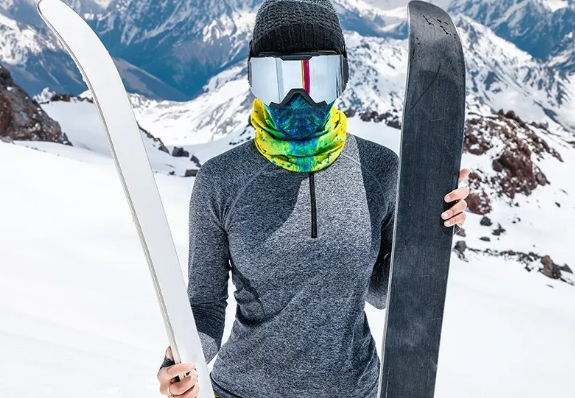
Wearing a neck gaiter or balaclava can make a significant difference in keeping you warm and comfortable while skiing. These accessories provide essential protection for your neck, face, and head in cold and windy conditions. Let's delve deeper into the benefits of using a neck gaiter or balaclava and how to choose the right one for your needs:
Neck Gaiter:
A neck gaiter is a tube of fabric that you can pull over your head and wear around your neck. Here's why it's beneficial:
- Neck and Face Protection: A neck gaiter covers your neck, shielding it from cold air, wind, and snow. You can also pull it up to cover your lower face and ears for added protection.
- Moisture Management: Quality neck gaiters are made from moisture-wicking materials that keep sweat away from your skin, preventing dampness and maintaining warmth.
- Breathability: Look for a gaiter with breathable fabric to ensure that you don't feel suffocated or overheated when covering your face.
- Versatility: A neck gaiter can be adjusted to cover different areas of your face and neck based on your comfort level and the weather conditions.
Balaclava:
A balaclava is a headgear garment that covers the entire head, neck, and often the face, leaving only the eyes exposed. Here's why it's advantageous:
- Full Coverage: A balaclava provides comprehensive coverage, protecting your head, neck, and face from extreme cold and wind.
- Insulation: Balaclavas are usually thicker than neck gaiters, offering greater insulation and warmth, especially in frigid conditions.
- Variations: There are different styles of balaclavas, including full-face designs with only an eye opening or more traditional ones that cover the entire head and neck but can be pulled down when not needed.
Choosing the Right Neck Gaiter or Balaclava:
- Material: Look for moisture-wicking, quick-drying materials like synthetic blends or merino wool. These fabrics help manage moisture and regulate your body temperature.
- Fit: Both neck gaiters and balaclavas should fit snugly but comfortably. Ensure that the fabric isn't too tight around your neck or face.
- Breathability: If you opt for a balaclava, make sure it has areas for breathability to prevent moisture buildup and fogging of glasses or goggles.
- Adjustability: Some neck gaiters and balaclavas come with adjustable drawstrings or toggles to customize the fit and seal out cold air.
- Compatibility: Ensure that your choice of neck gaiter or balaclava works well with your helmet and goggles.
- Layering: You can layer a neck gaiter or balaclava under your helmet or over a warm hat or helmet liner for added insulation.
In cold and windy skiing conditions, wearing a neck gaiter or balaclava can significantly enhance your comfort and protect your vulnerable areas from exposure. Choose the style that suits your preferences, and consider the level of coverage and insulation you need based on the weather conditions you'll be facing.
6) Warm Socks

Wearing warm and appropriate socks is crucial for keeping your feet comfortable and protected while skiing. Cold feet can quickly lead to discomfort and can even affect your overall skiing experience. Here's a more detailed look at the importance of warm socks for skiing and how to choose the right ones:
Importance of Warm Socks:
- Cold Feet Prevention: Cold feet can be extremely uncomfortable and distracting while skiing. Properly insulated socks help prevent heat loss and maintain a comfortable foot temperature.
- Moisture Management: Skiing involves physical activity, which can lead to sweating. Moisture-wicking socks help keep your feet dry by drawing sweat away from your skin, reducing the risk of chilling due to dampness.
- Circulation: Cold temperatures can constrict blood vessels and reduce blood circulation to the extremities. Warm socks help maintain proper blood flow to your feet, promoting comfort and preventing numbness.
- Blister Prevention: Quality ski socks are designed to reduce friction and prevent blisters. They are often seamless or have flat seams to minimize rubbing against your skin.
Choosing the Right Warm Socks:
- Material: Look for socks made from moisture-wicking, insulating materials such as merino wool or synthetic blends. Merino wool is excellent for its warmth, moisture management, and odor resistance.
- Thickness: Choose socks that provide sufficient insulation without making your ski boots too tight. Some ski socks come in different thicknesses, allowing you to match them to the weather conditions.
- Fit: Socks should fit snugly but not be too tight. Avoid overly bulky socks that can reduce blood circulation or lead to discomfort.
- Cushioning: Look for socks with cushioning in areas where you need extra padding, such as the heel and the ball of the foot.
- Height: Ski socks come in various heights, from ankle-length to over-the-calf. Over-the-calf socks provide extra coverage and protection against cold air and snow entering your boots.
- Seam Placement: Choose socks with minimal seams or seamless designs to prevent irritation and blisters.
- Ventilation Zones: Some socks have ventilation zones to enhance breathability and prevent overheating.
- Compression: Some ski socks offer light compression, which can help improve circulation and reduce muscle fatigue.
- Try Them On: It's essential to try on your ski socks with your ski boots to ensure they fit comfortably together. Avoid excessive bunching of material.
Layering with Socks:
Consider using a layering approach with socks as well:
- Base Layer Socks: Start with a thin moisture-wicking liner sock made of materials like merino wool or synthetic blends. This layer helps manage moisture.
- Insulating Socks: Over the liner socks, wear thicker, warmer ski-specific socks that provide insulation and cushioning.
- Boot Fit: Ensure that your combined sock layers fit comfortably inside your ski boots without making them too tight.
Remember that your choice of socks can significantly impact your comfort and performance on the slopes. Investing in high-quality ski socks designed for warmth, moisture management, and comfort is essential for an enjoyable skiing experience.
7) Thermal Underwear
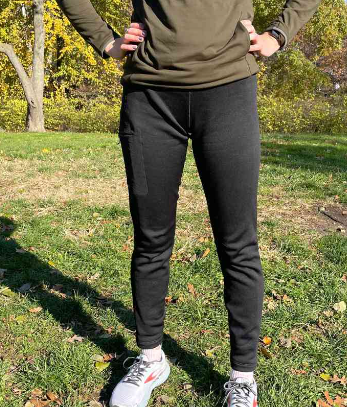
Thermal underwear, also known as long underwear or base layers, is a critical component of your skiing attire. It's designed to provide an extra layer of insulation and moisture management to keep you warm, dry, and comfortable in cold weather conditions. Here's an in-depth look at thermal underwear for skiing and what you should consider when choosing the right ones:
Importance of Thermal Underwear:
Insulation: Thermal underwear acts as an insulating layer, trapping warm air close to your body and preventing heat loss. This is crucial for maintaining your core body temperature in cold weather.
Moisture Management: Skiing involves physical activity, which can lead to sweating. Thermal underwear wicks moisture away from your skin, preventing dampness and subsequent cooling.
Layering: Thermal underwear forms the foundation of the layering system. It helps regulate your body temperature by effectively managing moisture and maintaining warmth, even in varying weather conditions.
Comfort: Well-designed thermal underwear provides a comfortable next-to-skin layer that minimizes friction and irritation from outer clothing layers.
Choosing the Right Thermal Underwear:
Material: Thermal underwear comes in various materials, including merino wool, synthetic blends, and silk. Each has its benefits:
Merino Wool: Offers excellent insulation, moisture-wicking properties, and natural odor resistance. It's comfortable against the skin and regulates temperature effectively.
Synthetic Blends: Often made from materials like polyester, these blends are lightweight, quick-drying, and provide good moisture management.
Silk: Provides a smooth and lightweight layer that's great for moderate cold conditions.
Weight: Thermal underwear comes in different weights: lightweight, midweight, and heavyweight. Choose the weight based on the weather conditions you'll be skiing in. Heavier weights provide more insulation but might be too warm for mild days.
Fit: Thermal underwear should fit snugly but not restrict your movement. A close fit helps with efficient moisture management and insulation.
Seam Placement: Look for thermal underwear with flat seams or minimal seam placement to prevent irritation against your skin.
Top and Bottom: Thermal underwear is available as both tops and bottoms. Consider getting both for full-body coverage and optimal warmth.
Ventilation: Some thermal underwear designs incorporate ventilation zones to enhance breathability in areas prone to sweating.
Layering with Thermal Underwear:
Base Layer: Start with a moisture-wicking thermal top and bottom as your base layer. This layer manages sweat and provides insulation.
Insulating Layer: Over your thermal underwear, add an insulating layer like a fleece jacket or down sweater for additional warmth.
Outer Layer: Complete your layering system with a waterproof and windproof outer jacket and pants.
Remember that thermal underwear is a foundational element of your skiing outfit. It plays a vital role in maintaining your body temperature, managing moisture, and enhancing your overall comfort while skiing. Choose the material and weight that best suits the weather conditions you'll be facing, and prioritize comfort and effective insulation when making your selection.
8) Proper Footwear
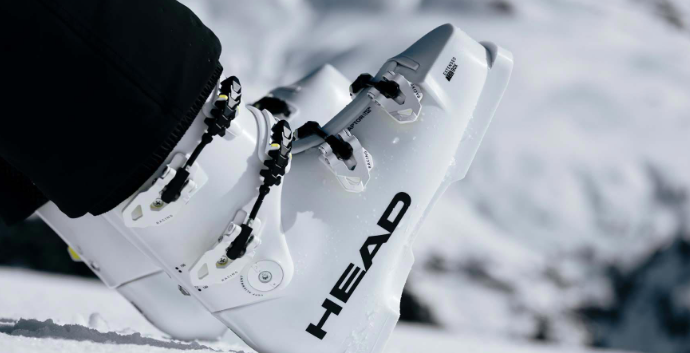
Choosing the right footwear is essential for a comfortable and enjoyable skiing experience. Proper ski boots and socks play a crucial role in keeping your feet warm, well-supported, and protected. Here's a comprehensive look at the importance of proper footwear for skiing and how to make the right choices:
Ski Boots:
Ski boots are the most critical piece of footwear for skiing. They directly influence your performance, control, and comfort on the slopes. Here's what to consider:
- Fit: Proper fit is paramount. Ski boots should fit snugly but not too tight, allowing for proper circulation and avoiding pressure points.
- Boot Flex: Ski boots come in various flex ratings, indicating their stiffness. Choose a flex rating appropriate for your skiing level and preferences. Stiffer boots offer better control for advanced skiers, while softer boots are more forgiving for beginners.
- Sole Type: Ski boots have either Alpine (downhill) or Touring (backcountry) soles. Make sure the sole type matches your bindings.
- Customization: Many modern ski boots offer customization options for fitting your foot shape. Customizable liners, footbeds, and buckles can enhance comfort.
- Warmth: Insulated liners can provide additional warmth. You can also wear moisture-wicking ski socks for better temperature regulation.
- Boot Fitting: Professional boot fitting is highly recommended. An expert can assess your feet, recommend suitable boots, and make adjustments for a perfect fit.
Foot Warmth Tips:
- Dry Feet: Make sure your boots and socks are dry before putting them on. Moisture inside your boots can lead to cold feet.
- Warm Up: Warm up your boots by placing them near a heater before putting them on. Avoid extreme heat that can damage the boots.
- Proper Buckling: Properly buckle or fasten your boots to prevent air gaps that can lead to cold spots.
- Use Boot Heaters: Battery-operated boot heaters can provide extra warmth on extremely cold days.
- Wiggle Toes: Wiggle your toes occasionally to encourage circulation and warmth.
- Take Breaks: If you start feeling uncomfortably cold, take breaks indoors to warm up your feet.
Remember that proper footwear is crucial for safety, comfort, and performance while skiing. Well-fitting ski boots and appropriate socks play a significant role in keeping your feet warm, supported, and ready for action on the slopes. If possible, seek professional guidance when selecting and fitting your ski boots to ensure an optimal experience.
9) Avoid Overdressing

Avoiding overdressing while skiing is essential to ensure your comfort, performance, and safety on the slopes. Overdressing can lead to excessive sweating, discomfort, and even coldness once you stop moving. Here's a detailed look at why overdressing should be avoided and how to strike the right balance:
Why Avoid Overdressing:
- Excessive Sweating: Overdressing can cause your body to overheat, leading to excessive sweating. This moisture can make your clothing wet, increasing the risk of feeling cold and uncomfortable once you stop moving.
- Moisture Retention: Wet clothing, due to sweating, can lead to moisture retention. As your body temperature decreases, the damp clothing can exacerbate the feeling of coldness.
- Chilling Effect: When you stop skiing or take a break, excessive sweat can lead to rapid cooling, making you feel much colder than you would have if you weren't overdressed.
- Reduced Mobility: Bulky or excessive layers can restrict your movement and hinder your skiing performance. This can be particularly problematic when navigating difficult slopes.
Consider Weather and Activity:
- Weather Conditions: Adjust your clothing based on the weather forecast. Warmer days might require fewer layers, while colder days demand more insulation.
- Activity Level: Your activity level greatly affects your body temperature. On more challenging runs, you might naturally generate more heat and need fewer layers.
Remember that striking the right balance between warmth and avoiding overheating is crucial for an enjoyable skiing experience. Be prepared to adjust your layers throughout the day based on how you feel and the changing conditions. By staying mindful of your body's signals and using a thoughtful layering approach, you can avoid the discomfort and potential risks of overdressing.
10) Stay Hydrated And Nourished
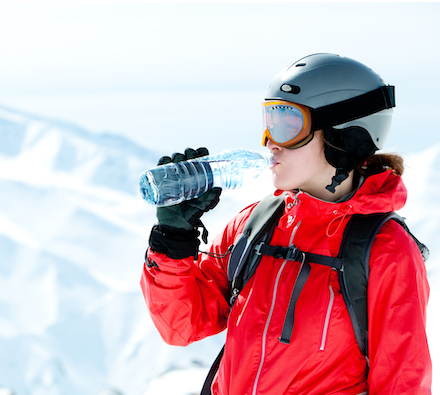
Staying hydrated and well-nourished is essential while skiing, as both factors play a significant role in maintaining your energy levels, performance, and overall well-being on the slopes. Here's an in-depth look at why hydration and proper nutrition matter when skiing, along with tips on how to ensure you're taking care of your body's needs:
Importance of Staying Hydrated:
Physical Activity: Skiing is a physically demanding activity that can lead to sweating and fluid loss. Dehydration can impair your performance, reduce endurance, and increase the risk of fatigue and muscle cramps.
Altitude: If you're skiing at high altitudes, the dry air and altitude itself can lead to increased fluid loss through respiration. Staying hydrated is even more crucial in such conditions.
Thermoregulation: Proper hydration helps regulate your body temperature. Dehydration can disrupt your body's ability to cool down, leading to overheating.
Tips for Staying Hydrated:
Drink Water Regularly: Consume water at regular intervals, even if you don't feel thirsty. Thirst might not always be an accurate indicator of your body's hydration status.
Pack a Hydration System: Consider using a hydration pack with a water reservoir that you can sip from easily without stopping.
Avoid Excessive Caffeine and Alcohol: Both caffeine and alcohol can contribute to dehydration. Limit your intake of these beverages, especially while skiing.
Eat Hydrating Foods: Foods with high water content, like fruits and vegetables, can contribute to your hydration levels.
Importance of Proper Nutrition:
Energy Levels: Skiing requires a considerable amount of energy. Proper nutrition provides the fuel your body needs to perform optimally.
Muscle Recovery: Adequate nutrition supports muscle recovery after intense physical activity, helping to reduce soreness and promote overall well-being.
Focus and Concentration: A well-balanced diet ensures that your brain functions at its best, helping you stay focused and alert on the slopes.
Tips for Proper Nutrition:
Eat Balanced Meals: Aim for balanced meals that include carbohydrates for energy, protein for muscle repair, and healthy fats for sustained energy.
Pre-Ski Breakfast: Start your day with a nutritious breakfast to provide you with the energy you need for skiing.
Snack Smart: Pack nutrient-rich snacks like nuts, trail mix, energy bars, and fruits to keep your energy levels steady throughout the day.
Hydrate with Electrolytes: Especially on long ski days or in extreme conditions, consider beverages with added electrolytes to help maintain your body's electrolyte balance.
Post-Ski Nutrition: After skiing, replenish your energy stores with a balanced meal that includes protein and carbohydrates. This helps with muscle recovery and preparation for the next day.
Listen to Your Body: Pay attention to your hunger cues and eat when you're hungry. Your body's needs can vary based on factors like activity level and weather conditions.
Avoid Heavy Meals: While it's important to nourish yourself, avoid heavy, large meals that might lead to discomfort while skiing.
Staying hydrated and nourished while skiing requires proactive planning. Pack snacks, carry a water bottle or hydration pack, and prioritize making time for meals and breaks. By taking care of your body's hydration and nutritional needs, you'll be better equipped to perform well, enjoy your skiing experience, and stay safe on the slopes.
11) Breaks in Sheltered Areas
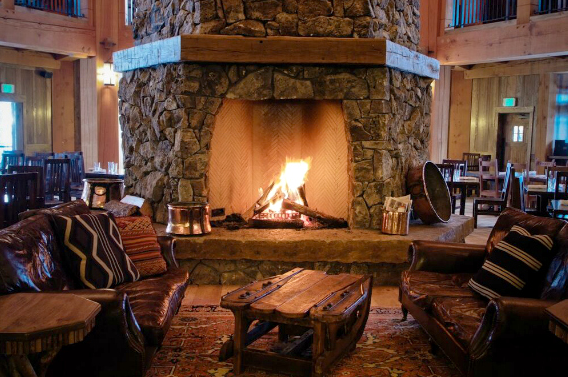
Taking breaks in sheltered areas while skiing is an important strategy for maintaining your comfort, safety, and well-being on the slopes. Sheltered areas provide protection from the elements, allowing you to rest, refuel, and recharge before continuing your skiing adventure. Here's an in-depth look at why breaks in sheltered areas matter and how to make the most of them:
Importance of Breaks in Sheltered Areas:
Rest and Recovery: Skiing is physically demanding, and taking breaks allows your muscles to recover, reducing the risk of fatigue and overexertion.
Warm-Up: Cold temperatures can lead to muscle stiffness. A break in a sheltered area provides an opportunity to warm up, stretch, and maintain flexibility.
Hydration and Nutrition: Breaks give you a chance to hydrate, eat snacks, and replenish energy levels, which are crucial for maintaining performance and preventing exhaustion.
Weather Protection: Sheltered areas shield you from wind, snow, and cold temperatures, reducing the risk of discomfort, hypothermia, and frostbite.
Making the Most of Breaks in Sheltered Areas:
Plan Ahead: Identify sheltered spots on the mountain where you can take breaks. Ski lodges, rest huts, or other designated sheltered areas are excellent options.
Warm-Up: Use breaks to stretch your muscles and get your blood flowing. Simple stretches can help prevent stiffness and improve your overall skiing experience.
Hydrate and Refuel: Drink water and consume nutrient-rich snacks during your break to maintain energy levels and stay hydrated.
Layer Adjustment: If you've been sweating while skiing, consider adjusting your layers during breaks. Removing a layer to prevent overheating or adding a layer to stay warm can enhance your comfort.
Rest and Relax: Sit down, relax, and enjoy the scenery during your break. Mental relaxation is as important as physical rest.
Check Equipment: Take the time to inspect your ski equipment, especially if you've encountered challenging terrain. Ensure your bindings, boots, and other gear are in proper working order.
Monitor Weather: Keep an eye on the weather conditions. If conditions worsen during your break, it might be wise to wait until they improve before resuming skiing.
Time Management: Be mindful of how much time you spend on breaks. Long breaks can lead to feeling stiff or getting too cold.
Socialize: If you're skiing with others, breaks provide an opportunity to connect, share experiences, and enjoy each other's company.
Stay Organized: Keep your gear organized during breaks. Uncluttered gear makes it easier to get back on the slopes quickly.
Sun Protection: Even on cloudy days, UV rays can be strong at higher altitudes. Apply sunscreen and protect your eyes with sunglasses or goggles.
Safety Considerations:
While breaks in sheltered areas are essential, always prioritize safety:
Avalanche Awareness: If you're skiing in backcountry or off-piste areas, be aware of avalanche risks. Sheltered areas might not be safe if there's avalanche danger.
Watch for Obstacles: Be cautious of obstacles or changing conditions while entering or exiting sheltered areas.
Visibility: In snowy or foggy conditions, be cautious of visibility changes when entering sheltered areas.
Remember that breaks in sheltered areas contribute to your overall skiing experience by allowing you to rest, refuel, and protect yourself from the elements. Use these moments strategically to enhance your comfort, safety, and enjoyment on the slopes.
12) Choose The Right Time To Ski
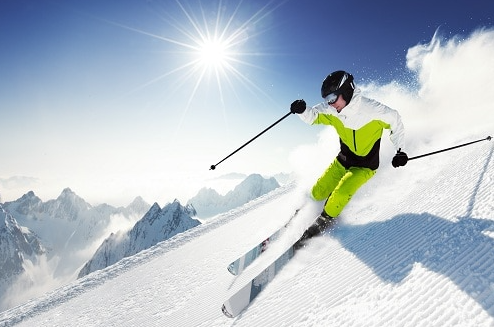
Choosing the right time to ski is a crucial decision that can greatly impact your skiing experience. Factors such as weather, snow conditions, crowd levels, and personal preferences all come into play. Here's a comprehensive look at why timing matters and how to make the best choice for your ski adventure:
Importance of Choosing the Right Time:
Weather and Snow Conditions: The time of day can influence weather conditions and the quality of the snow. Choosing the right time allows you to ski in optimal weather, good visibility, and the type of snow you prefer.
Safety: Picking the right time ensures that you're skiing in conditions suitable for your skill level. Adverse weather or poor visibility can affect your safety on the slopes.
Crowd Levels: Skiing during off-peak times helps you avoid long lift lines and crowded runs. This enhances your overall skiing experience and reduces the potential for accidents or collisions.
Sunlight: Sunlight can improve visibility and make the skiing environment more enjoyable. The right time can offer the best lighting conditions for you to navigate the slopes.
Tips for Choosing the Right Time to Ski:
Check Weather Reports: Always check the weather forecast before heading out. This will help you plan your skiing around the best weather conditions.
Early Mornings: Skiing early in the morning often means fewer people on the slopes, freshly groomed runs, and potentially quieter lifts.
Midweek Skiing: If your schedule allows, consider skiing on weekdays when ski resorts are typically less crowded than weekends and holidays.
Late Mornings: If you're not an early riser, aim to start skiing later in the morning to avoid the initial rush and enjoy less crowded slopes.
Lunch Breaks: Use the lunch break as an opportunity to rest and refuel while many skiers are off the slopes. This can also help you avoid the midday crowd.
Afternoon Skiing: Skiing in the afternoon can be ideal if you enjoy softer snow and more relaxed runs. The sun's warmth can soften the snow, creating more forgiving conditions.
Avoid Peak Hours: Mid-morning to early afternoon is typically the busiest time on the slopes. Try to ski before or after these hours to have a more enjoyable experience.
Local Knowledge: If you're unfamiliar with the ski resort, ask locals or resort staff for insights on the best times to ski based on conditions and crowd levels.
Personal Preferences:
Consider your own preferences and priorities when deciding on the right time to ski:
Skiing Style: If you prefer groomed runs and early mornings, starting your day early might be best. If you enjoy softer snow, afternoon skiing might be more suitable.
Crowd Preference: If you like quieter slopes, prioritize skiing during non-peak times. If you enjoy a lively atmosphere, you might opt for busier times.
Rest and Après-Ski: Plan your skiing around when you want to take breaks and enjoy apres-ski activities. This will help you balance physical activity with relaxation.
Photography: If you're interested in capturing beautiful mountain views, plan your skiing when the lighting is best for photography.
Remember that the right time to ski is a combination of practical factors, such as weather and crowd levels, as well as your personal preferences. By considering all these aspects, you can make the most of your time on the slopes and ensure a memorable skiing experience.
Wrapping Things Up
Staying warm while skiing is not only a matter of comfort but also a crucial element for safety and optimal performance on the slopes.
As we've explored in depth, a combination of well-chosen clothing, accessories, and strategic choices can make a significant difference in your skiing experience. From layering effectively with moisture-wicking base layers and insulating mid-layers to ensuring proper insulation through quality gloves, hats, and socks, every detail matters.
Additionally, taking breaks in sheltered areas, staying hydrated, and choosing the right time to ski contribute to your overall warmth and enjoyment.
By understanding the principles of layering, selecting the appropriate gear, and being mindful of your body's needs, you can overcome the challenges of cold temperatures and changing weather conditions.
Remember that finding the right balance between warmth and avoiding overheating requires attentiveness to your body's cues and the environment around you.
Whether you're a seasoned skier or just starting out, the knowledge and practices shared here can help you stay warm, comfortable, and ready to conquer the slopes while creating lasting memories of your skiing adventures.
And make sure to check out my guides to the best heated clothing:
